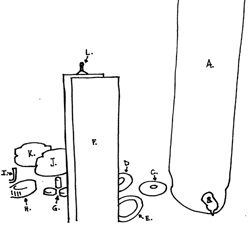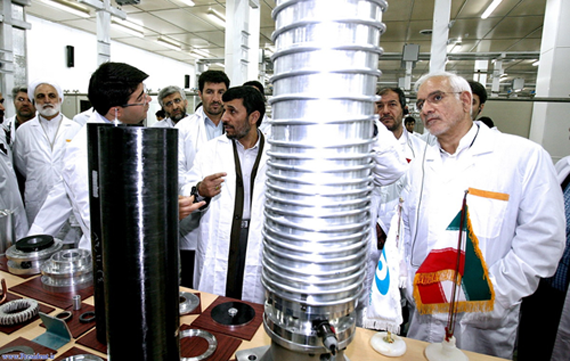I was looking at all the pretty components laid out on the table around the IR-2 carbon fiber rotor with a ball bearing on top and thought “It would be great to identify all the parts.”
So, I sent a note to Scott Kemp, at Princeton’s Program on Science and Global Security, that said, roughly “Look at all the pretty components laid out on the table around the IR-2 carbon fiber rotor with a ball bearing. It would be great to identify all the parts.”
He obliged. (Don’t blame him for the crude outline drawing, that’s mine.)
A. Vacuum casing, with cooling coils wrapped around exterior.
B. Electrical connection for Motor.
C. Lower end cap of rotor and armature plate.
D. Upper end-cap, with hole for feed pipes.
E. Weir baffle.
F. Carbon-fiber rotor, 62 cm long.
G. Magnetic bearing components.
H. Motor winding and stator.
I. Cooling loop for motor.
J. Base.
K. Base with motor.
L. Spiral groove pivot bearing.

Scott has an article coming out in Science and Global Security that will detail the history of the U.S. centrifuge program, including never-before-released technical details and a simple formula for policymakers to estimate the performance of a centrifuge.
It is part of a special issue on centrifuges that will also include papers by Alex Glaser — assessing breakout scenarios using P1-type centrifuges in n 164-machine cascades — and Houston Wood.


Like to know your opinion:
With the latest info on P2 or IR-2 and how Iran has gone public with it are they making a statement that have reached a point of no return in enrichment technology and are self sufficient? Can they sustain enrichment with IR-2 footprint (electrical and infrastructure requirement) if they go underground (Are they now bargaining to be part of the nuclear enrichment club?
Open Source Center, eat your heart out.
Amazing post. Thanks for the parts list.
“spiral groove pivot bearing” sounds like it should be the name of a p-funk album.
Do the two tubes on display suggest that each rotor consists of two tubes with a bellows? The height of the casing isn’t clear.
The other additional piece sitting the table is perhaps the most important clue yet: the Iranian flag. To my mind, that implies that Iran indigenously produced all the other components on the table.
The molecular pump is to the left of item K — it’s more visible in one of the other photographs.
“The other additional piece sitting the table is perhaps the most important clue yet: the Iranian flag. To my mind, that implies that Iran indigenously produced all the other components on the table.”
Are you being serious? I have a little American flag in my office that says “Made in China”. I don’t think the presence of that flag implies anything.
Can anyone identify the white and blue flag?
a thousand thanks for identifying the parts. now, what about the people? is Mohsen Fakhrizadeh among them? we could invite them to non-proliferation conferences.
Ignorant question: What are the red flags in the back of the room in 28852.jpg supposed to be of? Is the one second-from-right of a centrifuge cross-section of some kind?
Ask yourself why there was an Iranian flag on that table; a table full of pieces of centrifuge components. In no other picture is there an Iranian flag, though there would have been much better places for a flag. On the other hand, indigenous manufacturing of sophisticated components is something to be very proud of and showing them with an Iranian flag is a very good way of graphically proclaiming it. Since I doubt that your desk is being used to display anything to your President, I assume that your flag makes no such statement.
“Can anyone identify the white and blue flag?”
Its the AEOI flag.
I noticed Defense Minister Najjar amongst the crowd. Must be very interested in how that civilian program is coming along…
The blue and white flag next to the Iranian flag has the symbol for the Iranian atomic energy organization on it.
the blue flag is from the Atomic Energy Organization of Iran (AEOI)
http://www.aeoi.org.ir/
again, identifying the people is going to be much harder…
I am going to try to put captions to all the pictures.
Anyone want to help?
Question One:
Who is on the visit?
So far, in addition to Ahmadinejad, I think I see:
* Mostafa Mohammad-Najar, Defense Minister
* Saeed Jalili, Secretary, Supreme National Security Council (top nuclear negotiator)
* Kazem Jalali, Rapporteur of Majlis National Security and Foreign Policy Commission
* Gholam Reza Aghazadeh President, AEOI
* Mohammed Saeedi, Vice President AEOI
There are a couple of people I don’t recognize. The guy ith the round face and glasses and the guy with the white turban.
Thoughts?
Okay, I think the guy with the Turban is the intelligence minister, Hossein Mohseni Ejehei.
I also notice that the delegation includes Mohammad Mahdi Zahedi, the Science, Research, and Technology.
Who is representing the Foreign Ministry?